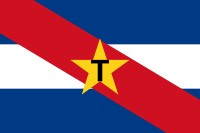Movimiento de Liberación Nacional - Tupamaros
The Tupamaros , full name Movimiento de Liberación Nacional - Tupamaros ( MLN-T , National Liberation Movement - Tupamaros ) were a communist guerrilla movement of Uruguay that was formed from union elements and was active as an underground movement from 1963 to the 1970s . It has been a political party since 1985.
Surname
The name is derived from the Peruvian rebel leader Túpac Amaru II (1738–1781). The Uruguayan people's army, which fought against the colonial power of Spain until 1811, called itself "Tupamaros".
history
During the 1960s, the Tupamaros still distanced themselves from armed actions and violence. It was important to them to appear more as a political movement than as a classic guerrilla . On the other hand, their concept of urban guerrilla specifically included disrespectful public relations work. From 1968 onwards, the government's measures against labor unrest in the country intensified, including the promulgation of emergency laws. Government measures included political arrests, the use of torture methods during interrogation and the violent crackdown on protests.
Since 1968 the Tupamaros have radicalized. That year they kidnapped Ulysses Pereira Reverbel, a leader in the Colorado Partido , and carried out several attacks and robberies (Hotel Casino Carrasco in Montevideo); Police shot dead students Líber Arce, Susana Pintos and Hugo de los Santos. The kidnapping and murder of high-ranking personalities by Tupamaros as well as the attacks in several large cities reached their peak in 1970 and 1971. During this time, she applied her concept of Carcél del Pueblo ( People's Prison ). The victims of their kidnappings, including, for example, the US CIA agent and security advisor to the Uruguayan interior authorities Daniel A. Mitrione , were arrested and interrogated and some were murdered, and the results of the interrogations were finally made available to the public. In 1971, more than a hundred Tupamaros escaped in a major prison break.
Politically, the movement did not achieve any change in government, which was evident in the 1971 election defeat of the left. In addition, the Tupamaros came under increasing military pressure from the Uruguayan army and police, which were also trained and supported by the US Office of Public Safety . The massive use of force weakened the movement and by 1972 numerous leaders had been arrested. Among other things, the leader Raúl Sendic was arrested and, like many others, imprisoned until the end of the military dictatorship in 1985. Surviving senior members decided at that time to take part in the democratic elections. They founded the movement for popular participation ( Movimiento de Participación Popular ), which has now become the strongest faction of the left-wing party alliance Frente Amplio . In October 2004, the party alliance won the elections and has been in power since then. One of the former leading members of the Tupamaros, José Mujica , was Minister of Agriculture from 2005 to 2008 and President from 2010 to 2015 .
"Tupamaros" in Western Europe
The conception of the Tupamaros was often imitated in Europe with different political orientations, first from 1969 by the Tupamaros West Berlin and Tupamaros Munich and then by the Italian Red Brigades , the German Red Army Faction and the June 2nd Movement .
Movies
- Costa-Gavras : The Invisible Revolt . original État de Siège (1972)
- Rainer Hoffmann , Heidi Specogna : Tupamaros . Documentary with Pepe Mujica et al. (1997)
literature
- Fritz René Allemann : Power and impotence of the guerrillas. R. Piper & Co., Munich 1974.
- Ernesto G. Bermejo: Hands in the fire. A Tupamaro looks back. (“Los manos en el fuego”). Focus-Verlag, Giessen 1986, ISBN 3-88349-341-4 .
- Thomas Fischer: The Tupamaros in Uruguay. The model of the urban guerrilla. In: Wolfgang Kraushaar (ed.): The RAF and left-wing terrorism. Volume 2. Hamburger Edition, Hamburg 2006, ISBN 978-3-936096-65-1 , pp. 736-750.
- Alain Labrousse: The Tupamaros. Urban guerrilla in Uruguay. ("Les tupamaros") Hanser, Munich 1971, ISBN 3-446-11419-X . (Hanser series; 65).
- Alfonso Lessa: La revolución imposible. Los Tupamaros y el fracaso de la vía armada en el Uruguay del siglo XX , Montevideo 2010. ISBN 978-9974-68344-0
- Gerardo Tagliaferro: Adiós Robin Hood. 7 tupamaros, 40 años después. Montevideo 2008. ISBN 978-9974-49423-7
Web links
- Homepage of the Tupamaros (Spanish)
Footnotes
- ↑ Vania Markarian: El 68 uruguayo. El movimiento estudiantil entre molotovs y música beat . Universidad Nacional de Quilmes, Bernal 2012, ISBN 978-987-558-240-8 , p. 46.
- ^ Eduardo Rey Tristán: A la vuelta de la esquina. La izquierda revolucionaria uruguaya, 1955-1973 . Editorial Fin de Siglo, Montevideo 2006, ISBN 9974-49-380-3 , p. 332.

